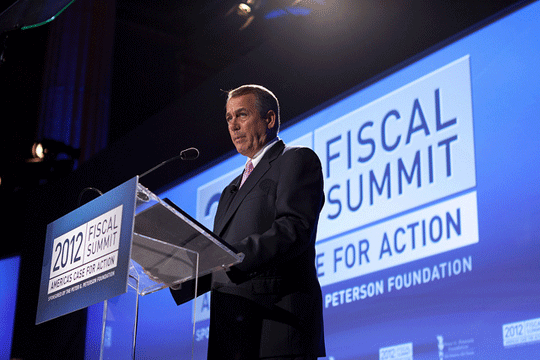Speaker Boehner pledges to hijack the debt ceiling and jeopardize recovery again
At this week’s Peter G. Peterson Foundation 2012 Fiscal Summit, an event dedicated to avoiding the merest possibility that the United States could ever find itself in a sovereign debt crisis, Speaker of the House John Boehner (R-Ohio) was invited to address the assembled crowd, wherein he pledged … to try to maximize the possibility of a sovereign debt crisis.
Specifically, he pledged a repeat of last summer’s showdown over the statutory debt ceiling, when congressional Republicans concocted an artificial crisis of epic proportions, by refusing the historically pro forma task of raising the debt ceiling—done 73 times between 1940 and 2010—unless deep spending cuts were made. This time around, Boehner literally suggested that it would be more responsible to default on the full faith and credit of the United States than to increase the statutory debt ceiling without first hijacking the U.S. credit rating to extract spending cuts:
“Yes, allowing America to default would be irresponsible. But it would be more irresponsible to raise the debt ceiling without taking dramatic steps to reduce spending and reform the budget process… When the time comes, I will again insist on my simple principle of cuts and reforms greater than the debt limit increase.” (Full transcript here.)
Rather than indulge the revisionist histories of last summer invoked by Boehner and others at the Fiscal Summit, here’s a refresher on what happened with the last episode of economic and fiscal “responsibility.” First, Republican leaders demanded policy concessions before agreeing to raise the debt ceiling; after the Obama administration conceded to this, Republican leadership walked away from negotiations over a deficit reduction “grand bargain,” first with Vice President Biden, then from negotiations with President Obama. Republican leadership demanded a dollar in spending cuts for every dollar increase in the debt ceiling, refused any revenue increases accompanying spending reductions, and refused any compromise. Obama and Boehner formally negotiated a variation of these demands on July 31, two-and-a-half months after the Treasury Department declared a “debt issuance suspension period” of unconventional cash-management tools to avoid a sovereign default. The resulting Budget Control Act (BCA) cleared the Senate and was signed into law August 2, the last day Treasury could avoid defaulting.

(From Flickr Creative Commons via SpeakerBoehner)
Shortly thereafter, rating agency Standard & Poor’s exercised “responsibility” in the Boehner sense of the word—i.e., trying to leverage the political debate over debt ceiling into concrete economic damage—by downgrading the U.S. “AAA” credit rating for the first time in history based on a judgment about dysfunctional politics (their economic justification was dropped after the Treasury Department found a $2 trillion error in their budget math). As for the “compromise” that ended the standoff, the BCA solidified Congress’ pivot from prioritizing job creation to prioritizing austerity measures like those that have pushed much of Europe back into recession, even though near-term cuts are largely to entirely self-defeating while the Federal Reserve keeps short-term rates at zero. My colleague Ethan Pollack and I estimated that the first phase of spending cuts would shave 0.3 percentage points from real GDP growth in 2012 and lower employment by 323,000 jobs; the second phase of front-loaded, automatic “sequestration” cuts scheduled for fiscal 2013 and beyond pose graver risks to growth and joblessness.
There are only two theoretical ways in which long-term deficit reduction can accelerate economic recovery. First (and actually plausible), a long-term deficit reduction “grand bargain” could include substantial near-term fiscal stimulus and gradually phase-in deficit reduction after some macroeconomic trigger is met (e.g., EPI proposed a “6-for-6” trigger: unemployment at or below 6 percent for six consecutive months). Second, deficit reduction could lower the premium on government borrowing, and thus private interest rates. This second channel actually has no hope of actually working today, as longer-term Treasury yields are already at historically low levels. Making all future increases in the debt ceiling completely uncertain and chaotic, however, will almost certainly impede both channels in the future.
And this strategy of promising to hold the full faith and credit of the United States hostage in exchange for spending cuts seems entrenched as the GOP strategy. This should not be mistaken simply for excessive zeal for cutting deficits; this is playing chicken with a self-induced sovereign debt crisis. Informed deficit hawks (and they exist—they just put vastly insufficient weight on solving the actually existing jobs crisis, in our view) endorse long-term deficit reduction as a means to avoid a sovereign debt crisis, not cause one.
The statutory debt ceiling has devolved from a pro forma vote into a global economic liability that Congress should put to rest. It seems clear that anybody interested in a sane economic policy regime should be looking for ways to repeal the debt ceiling, either in law or in practice. Time to bring on the $1 trillion coin?
Enjoyed this post?
Sign up for EPI's newsletter so you never miss our research and insights on ways to make the economy work better for everyone.